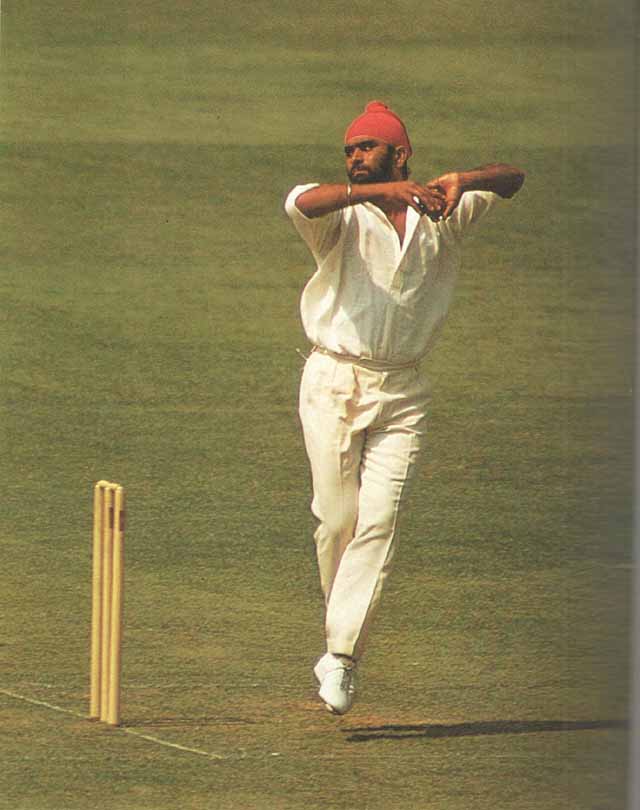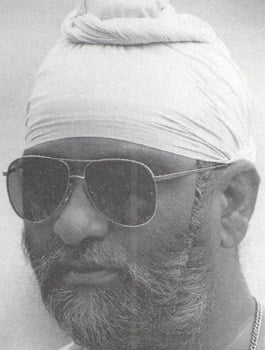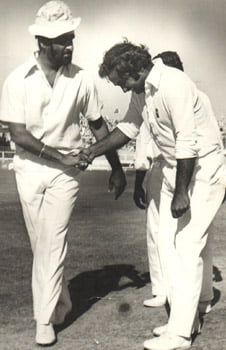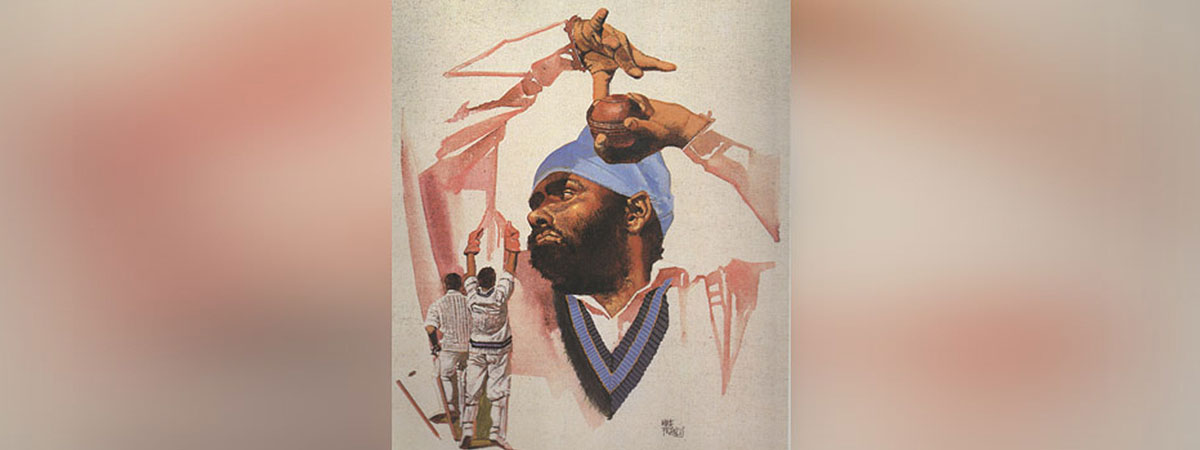A slow left arm bowler of classic mould, Bishan Singh Bedi, in many ways was one of the most colourful characters of the 1970s. In an era dominated by fearsome pace and aggressive batsman-ship, the Indian spin-quartet of Prasanna, Chandra (short for Chandrasekhar), Venkat (short for Venkataraghavan) & Bedi, with a combined total of 853 Test wickets to their credit, kept the art of slow bowling very much alive and kicking.
The Indian team’s success for almost four decades had relied solely on its slow bowlers till the arrival of Kapil Dev in 1978. The quartet offered a high skill level and all four were different in style and variation. Prassana, a wily off-spinner and Chandra; a medium-paced leg-break googly bowler hailed from Karnatka whereas Venkat, another off-spinner, represented Tamil Nadu.
With the inclusion of Bedi, a whole-hearted Punjabi, it made for a good mix in terms of regional representation of a vast country as India.
Bedi’s look, presence, ethnicity, religion and temperament, all got noticed. He stood out from the rest of the Indian team as the only Sikh, who wore a turban and among the spinning-quartet, the most attacking and the only one from the northern half of India
Born in Amritsar; city of the Golden Temple, the most sacred of shrines of the Sikh religion on 25th September 1946, it is said Bedi had only taken to cricket about two years prior to his first-class debut for Northern India in the 1961-62 Ranji Trophy. A short economical run-up was part of his classical side-on action with flight and loop to snarl his victims; he was a great find for Indian cricket.

At 20 Bedi was first chosen for India, in the 1966-67 series against West Indies at Calcutta where he settled down quickly. With a bit more support from the other end, Bedi with figures of 4-81 in the next Test at Madras, would have taken India to a surprise win before Gary Sobers (74*) and Charlie Griffith (40*), survived the last 90 minutes of play.
Bedi’s look, presence, ethnicity, religion and temperament, all got noticed. He stood out from the rest of the Indian team as the only Sikh, who wore a turban and among the spinning-quartet, the most attacking and the only one from the northern half of India.
Bedi was an understudy of Prassana and Nadkarni in India’s first ever Test series win abroad – against New Zealand in 1967-68 and contributed with 16 wickets @ 23.18 in the 4 matches. A welcome relief, for skipper M.A.K. Pataudi, who came under increased pressure to lift the standing of Indian cricket, badly rocked after being whitewashed in England (0-3) and Australia (0-4).
It was at Calcutta in 1969-70 when Bedi achieved his Test best analysis of 7-98 off 50 overs with 19 maidens, all the more significant for both Prassana and Venkat were wicket-less in their combined 65 overs and Australia’s total of 335 was enough to guarantee them a ten-wicket win.
India achieved its first victory against West Indies in the 25th Test between the two sides in the 1970-71 series at Port-of-Spain, Trinidad. On a surface that suited slow bowling, Bedi, Prassana, Venkat and Salim Durani, shared 17 wickets. The rest of the four Test matches ended with no result and India achieved a historic series win in the Caribbean. Few months later at The Oval, Indian cricket finally broke shackles and achieved an unlikely 4 wicket win, its first in England. The victorious Indian team was accorded the status of national heros. Three of its members, Bedi along with Farokh Engineer and Sunil Gavaskar were chosen for World XI squad on the tour of Australia in 1971-72. A welcome opportunity for Bedi and other two Indian players to get so form life-long
The renewal of cricket ties between India and Pakistan in 1978-79, following a gap of 17 years, was a tremendous boost for the sub-continent, on all fronts. The two captains and close friends – Mushtaq and Bedi – made sure the series was played in good spirit. With the exception of an ODI at Sahiwal where Bedi protested to umpires against short bowling by Pakistan pacemen and conceded the match, the tour was a grand advertisement for the future of India-Pakistan cricket
Bedi thrived in long spells and was never known to bowl defensively, continually enticing batsmen to come out of the crease and play expansive strokes. He did not mind applauding batsmen playing good strokes of his own bowling for it was part of a plan for he had an arm ball which after pitching would simply skid through the defences of many a great batsman. Till that time Indians were generally not known for their athleticism and Bedi was no exception and it was regular yoga that kept him in shape for the demands of domestic and international cricket.
In the 1972-73 winter, an MCC team led by Tony Lewis arrived to play a 5-Test series in India. The sight of half a dozen close-in fielders, including Solkar as the finest of his kind alongside the slow craftsmen spinning their web on the English batsmen led to India achieving a hat-trick of Test series wins. A proud moment indeed, in the history of Indian cricket that played its first Test back in 1932.

After claiming his 100th wicket at Delhi, in Calcutta, with India one Test down and defending a target of 192, Bedi showed his true colours. Brought on with the shine still on, he bowled 40 overs to pick up 5 for 63 to see India win the Test by 28 runs. In the 3rd Test at Madras, Bedi’s second innings return of 4 for 38 off 43 overs stifled the opposition and India won by 4 wickets.
In 1973, Bedi signed up to play for Northamptonshire in English county cricket. It was a happy and prosperous move for he instantly formed a friendship with Pakistan’s Mushtaq Mohammed and twice took 100 wickets in a season.
The pair were joined by Sarfraz Nawaz in 1974 and it was whilst Mushtaq as captain, the county won its first ever silverware when it beat Lancashire in the final of the 1976 Gillette Cup at Lord’s. Never shy to toss up the ball even in limited overs cricket, Bedi achieved figures of 12-8-6-1 for India against East Africa at Leeds in the 1975 Prudential World Cup. Both Bedi and Mushtaq were not offered contracts after the 1977 season.
The India-West Indies 1974-75 series proved an absorbing contest between the two sides, played in front of full house at each of the five Test centres. Bedi absent from the opening Test at Bangalore whilst serving a disciplinary ban, returned in the second Test at Delhi.
The hosts had lost the first two Test matches before turning the tables to square the series at 2-2. India won at Calcutta by 85 runs where Bedi picked up 4-52 in the second innings and another six wickets in the 4th Test at Madras.
The final and deciding Test match was a six-day contest at the new venue; Wankhede Stadium, Bombay. Once West Indies had posted 604 for 6 declared in their first innings, it more or less dominated the high-scoring match and won the series 3-2.
Bedi was appointed captain of the Indian team for the 1975-76 winter with away series against New Zealand and West Indies. A new-look Indian team without the household names such as Pataudi, Wadekar, Engineer, Solkar and Abid Ali were quick to adapt in both countries and performed better than was expected of them. The series in New Zealand was drawn 1-1 and in West Indies, India became only the second side in history to score over 400 runs to achieve a Test victory, after Australia against England at Leeds in 1948. In one of the most remarkable results, India levelled the series at Port-of-Spain with hundreds from Gavaskar and Viswanath, two of India’s finest batsmen.
The final Test on a recently re-laid pitch at Sabina Park, Kingston, ended in a farce when Bedi, fearing serious injury to his players against the hostile pace of Holding and Daniel closed the Indian second innings at 97, with three front-line batsmen absent through injuries in the first innings and two tail enders, Bedi himself and Chandra, reluctant to pad up. Bedi was protesting, both against the quality of the wicket and the body-line tactics employed by West Indies bowlers.
A controversial and anti-climax end to what could have been another fascinating contest. Bedi’s forthright stand did not get the mileage it deserved as West Indian fast bowling supremacy took its roots and was to last for two decades.

In the 1976-77 season, India hosted New Zealand and England and were on cards to win both series primarily with its world-class spinners, bowling in tandem for hours on end. The romance of India cricket crossed the border to reach Pakistan through the radio waves. It was simply impossible not to fall in love with the great game of cricket described so beautifully in Hindi language.
With a crowd in access of 50,000 on each day of a Test match, there was absolutely no chance of a dull moment despite often slow and attrition cricket. By now Bedi had swapped his traditional pug (turban) with a more practical head-cover, known as a patka (a tightly fitted round cap to hold his long hair). On a long day in the field, Bedi would emerge for each of the three sessions wearing different colours.
In the series against New Zealand, Bedi, at his very best in home conditions, picked up 22 wickets @ 13.18 – nearly earning India’s first ever whitewash – and he also brought up his only fifty with the bat in the 2nd Test at Kanpur. By losing the first three Test matches at Delhi, Calcutta and Madras, Tony Greig’s English side had won the series.
Bedi was still bowling well – he became the first Indian bowler to claim 200 wickets in his 51st Test at Madras – but had not been able to run through or have an impact on the outcome. In the 4th Test at Kanpur, his 6-71 in the second innings brought his side, a consolation win by 140 runs. The final outcome was disappointing as England won by 3-1 with Bedi coming under fire for a Test series defeat at home. The selectors still backed him.
The year 1977 would go down as the year of turmoil in world cricket with the emergence of Kerry Packer, an Australian media tycoon, who signed up most of the top international cricketers from all around the world for his World Series Cricket. With the exception of Jeff Thomson, the entire Australian squad had defected to play in these matches, when Indian undertook its first series Down Under after 10 years. As no Indian player signed to play in World Series Cricket matches, the tourists were at full strength.
The Australian selectors named 41-year old Bob Simpson, who had not played international cricket after 1967-68 Australia-India Test series, as their new captain. Australia won the first two Tests, both by a narrow margin: 16-run win at Brisbane and 2-wicket win at Perth. Even a ten-wicket haul by their skipper could not save India at Perth. In the third match at Melbourne, India achieved its first Test victory in Australia courtesy of their spin-twin of Bedi who claimed 6 wickets in the game and Chandra who claimed 12. Now with their tails up India squared the series by beating the home side by an innings and 2 runs at Sydney.
A fascinating Test series came to its conclusion at Adelaide when India were all out for 445 thus losing a great game of cricket by 47 runs, fighting every inch on their way on the sixth and final day. Both Simpson and Bedi deservedly took credit for a well-contested series. On a personal note, 31 wickets @23.87 was the best haul of his career.
The renewal of cricket ties between India and Pakistan in 1978-79, following a gap of 17 years, was a tremendous boost for the sub-continent, on all fronts. The two captains and close friends – Mushtaq and Bedi – made sure the series was played in good spirit. With the exception of an ODI at Sahiwal where Bedi protested to umpires against short bowling by Pakistan pacemen and conceded the match, the tour was a grand advertisement for the future of India-Pakistan cricket.
Pakistan with its World Series Cricket players back in the fold was a much stronger unit than the Indians. Having fought well throughout the 3-Test series, Indian bowlers now with its spinning quartet coming to the end of their careers, just could not stop the rampant Pakistan team to achieve two thrilling last-day victories at Lahore and Karachi. Bedi, not quite the force of the yore, was removed from the captaincy and replaced by vice-captain, Sunil Gavaskar.
Within a year after his dismissal as captain, Bedi was made redundant to the Indian team and replaced by Dilip Doshi in the 1979-80 home series against Australia. A great era of Indian spin bowling was over and two of its greats: Bedi with 266 wickets in 67 Tests and his partner Chandra with 242 in 58 Tests bowed out of the international arena.
